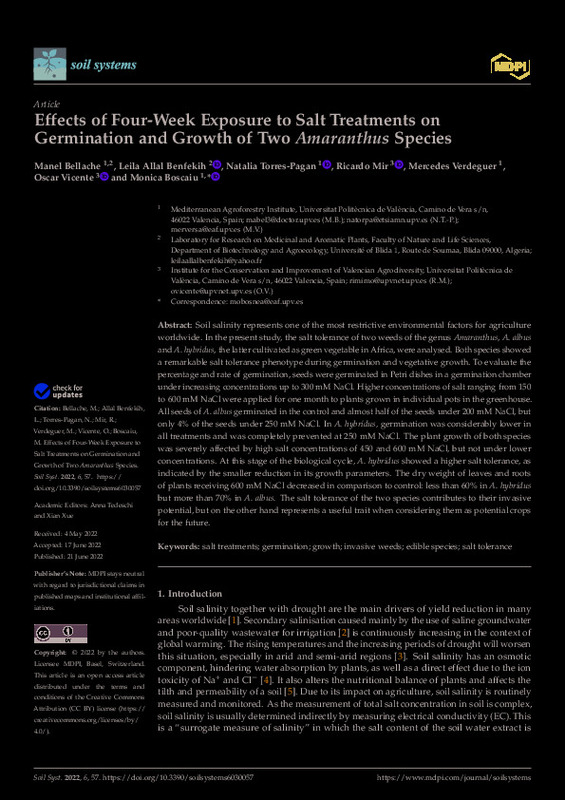JavaScript is disabled for your browser. Some features of this site may not work without it.
Buscar en RiuNet
Listar
Mi cuenta
Estadísticas
Ayuda RiuNet
Admin. UPV
Effects of four-week exposure to salt treatments on germination and growth of two Amaranthus species.
Mostrar el registro sencillo del ítem
Ficheros en el ítem
| dc.contributor.author | Bellache, Manel
|
es_ES |
| dc.contributor.author | Benfekih, Leila Allal
|
es_ES |
| dc.contributor.author | Torres-Pagán, Natalia
|
es_ES |
| dc.contributor.author | Mir Moreno, Ricardo
|
es_ES |
| dc.contributor.author | Verdeguer Sancho, Mercedes María
|
es_ES |
| dc.contributor.author | Vicente, Oscar
|
es_ES |
| dc.contributor.author | Boscaiu, Monica
|
es_ES |
| dc.date.accessioned | 2023-07-24T18:02:20Z | |
| dc.date.available | 2023-07-24T18:02:20Z | |
| dc.date.issued | 2022-09 | es_ES |
| dc.identifier.uri | http://hdl.handle.net/10251/195415 | |
| dc.description.abstract | [EN] Soil salinity represents one of the most restrictive environmental factors for agriculture worldwide. In the present study, the salt tolerance of two weeds of the genus Amaranthus, A. albus and A. hybridus, the latter cultivated as green vegetable in Africa, were analysed. Both species showed a remarkable salt tolerance phenotype during germination and vegetative growth. To evaluate the percentage and rate of germination, seeds were germinated in Petri dishes in a germination chamber under increasing concentrations up to 300 mM NaCl. Higher concentrations of salt ranging from 150 to 600 mM NaCl were applied for one month to plants grown in individual pots in the greenhouse. All seeds of A. albus germinated in the control and almost half of the seeds under 200 mM NaCl, but only 4% of the seeds under 250 mM NaCl. In A. hybridus, germination was considerably lower in all treatments and was completely prevented at 250 mM NaCl. The plant growth of both species was severely affected by high salt concentrations of 450 and 600 mM NaCl, but not under lower concentrations. At this stage of the biological cycle, A. hybridus showed a higher salt tolerance, as indicated by the smaller reduction in its growth parameters. The dry weight of leaves and roots of plants receiving 600 mM NaCl decreased in comparison to control: less than 60% in A. hybridus but more than 70% in A. albus. The salt tolerance of the two species contributes to their invasive potential, but on the other hand represents a useful trait when considering them as potential crops for the future. | es_ES |
| dc.language | Inglés | es_ES |
| dc.publisher | MDPI AG | es_ES |
| dc.relation.ispartof | Soil Systems | es_ES |
| dc.rights | Reconocimiento (by) | es_ES |
| dc.subject | Salt treatments | es_ES |
| dc.subject | Germination | es_ES |
| dc.subject | Growth | es_ES |
| dc.subject | Invasive weeds | es_ES |
| dc.subject | Edible species | es_ES |
| dc.subject | Salt tolerance | es_ES |
| dc.subject.classification | BIOQUIMICA Y BIOLOGIA MOLECULAR | es_ES |
| dc.subject.classification | BOTANICA | es_ES |
| dc.title | Effects of four-week exposure to salt treatments on germination and growth of two Amaranthus species. | es_ES |
| dc.type | Artículo | es_ES |
| dc.identifier.doi | 10.3390/soilsystems6030057 | es_ES |
| dc.rights.accessRights | Abierto | es_ES |
| dc.contributor.affiliation | Universitat Politècnica de València. Instituto Universitario de Conservación y Mejora de la Agrodiversidad Valenciana - Institut Universitari de Conservació i Millora de l'Agrodiversitat Valenciana | es_ES |
| dc.contributor.affiliation | Universitat Politècnica de València. Escuela Técnica Superior de Ingeniería Agronómica y del Medio Natural - Escola Tècnica Superior d'Enginyeria Agronòmica i del Medi Natural | es_ES |
| dc.description.bibliographicCitation | Bellache, M.; Benfekih, LA.; Torres-Pagán, N.; Mir Moreno, R.; Verdeguer Sancho, MM.; Vicente, O.; Boscaiu, M. (2022). Effects of four-week exposure to salt treatments on germination and growth of two Amaranthus species. Soil Systems. 6(3):1-16. https://doi.org/10.3390/soilsystems6030057 | es_ES |
| dc.description.accrualMethod | S | es_ES |
| dc.relation.publisherversion | https://doi.org/10.3390/soilsystems6030057 | es_ES |
| dc.description.upvformatpinicio | 1 | es_ES |
| dc.description.upvformatpfin | 16 | es_ES |
| dc.type.version | info:eu-repo/semantics/publishedVersion | es_ES |
| dc.description.volume | 6 | es_ES |
| dc.description.issue | 3 | es_ES |
| dc.identifier.eissn | 2571-8789 | es_ES |
| dc.relation.pasarela | S\470873 | es_ES |
| dc.subject.ods | 15.- Proteger, restaurar y promover la utilización sostenible de los ecosistemas terrestres, gestionar de manera sostenible los bosques, combatir la desertificación y detener y revertir la degradación de la tierra, y frenar la pérdida de diversidad biológica | es_ES |








